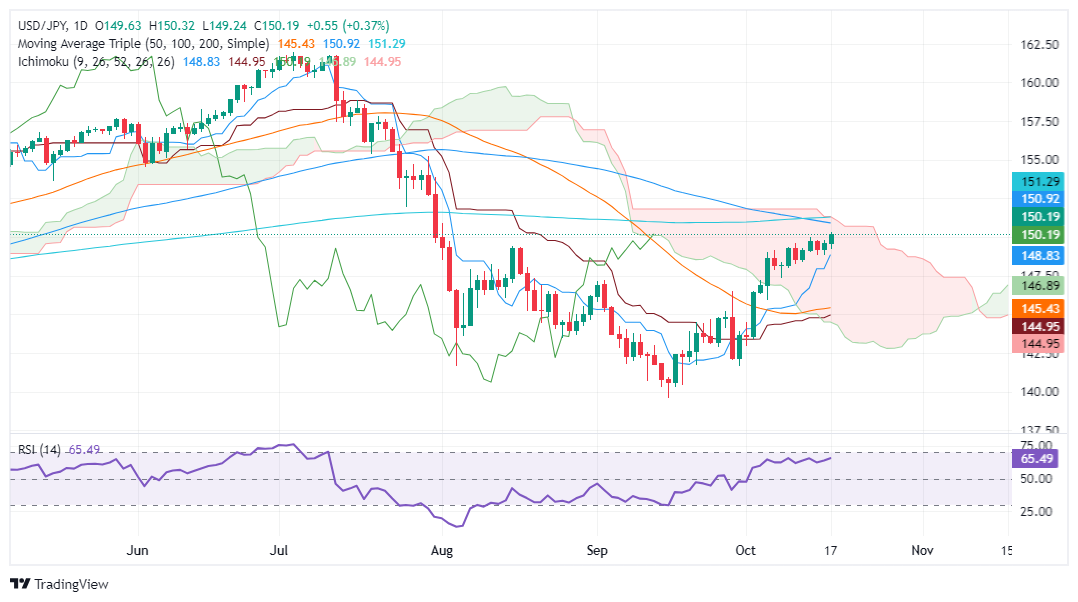- Analiza
- Novosti i instrumenti
- Vesti sa tržišta
- USD/JPY Price Forecast: Rallies above 150.00 on strong US Dollar
USD/JPY Price Forecast: Rallies above 150.00 on strong US Dollar
- USD/JPY trades at 150.21, extending its gains for a second consecutive day amid rising US bond yields.
- RSI signals growing bullish momentum, with the pair approaching key resistance at the top of the Ichimoku Cloud (Kumo).
- Next resistance levels include the 100-DMA at 150.85 and the 200-DMA at 151.32, with support at 150.00 and 149.00.
The USD/JPY climbs past the 150.00 figure on upbeat US Retail Sales and jobs data, gains over 0.38%, and trades at 150.21. The pair extended its gains for the second consecutive day, as US Treasury bond yields soared, due to investors trimming the odds for a Fed 25 basis points (bps) rate cut at the upcoming November meeting.
USD/JPY Price Forecast: Technical outlook
The USD/JPY continues its upward trajectory, and it is about to test the top of the Ichimoku Cloud (Kumo). Technical indicators suggest the major is on an uptrend, though a clear break above the Kumo is needed before the trend is confirmed.
The Relative Strength Index (RSI) cleared the last three peaks, hinting that buyers are gathering steam.
If USD/JPY resumes its bullish uptrend, buyers will face the 100-day moving average (DMA) at 150.85. Once surpassed, the next stop would be the confluence of the top of the Kumo and the 200-DMA at 151.32, ahead of extending those gains to 152.00.
Conversely, USD/JPY first support would be 150.00. Once surpassed, the next stop would be the 149.00 mark, ahead of the Tenkan-Sen at 148.84. If those levels are taken, the next support would be the Senkou Span A at 14690, followed by the 50-DMA at 145.50.
USD/JPY Price Action – Daily Chart
Japanese Yen FAQs
The Japanese Yen (JPY) is one of the world’s most traded currencies. Its value is broadly determined by the performance of the Japanese economy, but more specifically by the Bank of Japan’s policy, the differential between Japanese and US bond yields, or risk sentiment among traders, among other factors.
One of the Bank of Japan’s mandates is currency control, so its moves are key for the Yen. The BoJ has directly intervened in currency markets sometimes, generally to lower the value of the Yen, although it refrains from doing it often due to political concerns of its main trading partners. The BoJ ultra-loose monetary policy between 2013 and 2024 caused the Yen to depreciate against its main currency peers due to an increasing policy divergence between the Bank of Japan and other main central banks. More recently, the gradually unwinding of this ultra-loose policy has given some support to the Yen.
Over the last decade, the BoJ’s stance of sticking to ultra-loose monetary policy has led to a widening policy divergence with other central banks, particularly with the US Federal Reserve. This supported a widening of the differential between the 10-year US and Japanese bonds, which favored the US Dollar against the Japanese Yen. The BoJ decision in 2024 to gradually abandon the ultra-loose policy, coupled with interest-rate cuts in other major central banks, is narrowing this differential.
The Japanese Yen is often seen as a safe-haven investment. This means that in times of market stress, investors are more likely to put their money in the Japanese currency due to its supposed reliability and stability. Turbulent times are likely to strengthen the Yen’s value against other currencies seen as more risky to invest in.
© 2000-2025. Sva prava zaštićena.
Sajt je vlasništvo kompanije Teletrade D.J. LLC 2351 LLC 2022 (Euro House, Richmond Hill Road, Kingstown, VC0100, St. Vincent and the Grenadines).
Svi podaci koji se nalaze na sajtu ne predstavljaju osnovu za donošenje investicionih odluka, već su informativnog karaktera.
The company does not serve or provide services to customers who are residents of the US, Canada, Iran, The Democratic People's Republic of Korea, Yemen and FATF blacklisted countries.
Izvršenje trgovinskih operacija sa finansijskim instrumentima upotrebom marginalne trgovine pruža velike mogućnosti i omogućava investitorima ostvarivanje visokih prihoda. Međutim, takav vid trgovine povezan je sa potencijalno visokim nivoom rizika od gubitka sredstava. Проведение торговых операций на финанcовых рынках c маржинальными финанcовыми инcтрументами открывает широкие возможноcти, и позволяет инвеcторам, готовым пойти на риcк, получать выcокую прибыль, но при этом неcет в cебе потенциально выcокий уровень риcка получения убытков. Iz tog razloga je pre započinjanja trgovine potrebno odlučiti o izboru odgovarajuće investicione strategije, uzimajući u obzir raspoložive resurse.
Upotreba informacija: U slučaju potpunog ili delimičnog preuzimanja i daljeg korišćenja materijala koji se nalazi na sajtu, potrebno je navesti link odgovarajuće stranice na sajtu kompanije TeleTrade-a kao izvora informacija. Upotreba materijala na internetu mora biti praćena hiper linkom do web stranice teletrade.org. Automatski uvoz materijala i informacija sa stranice je zabranjen.
Ako imate bilo kakvih pitanja, obratite nam se pr@teletrade.global.
















